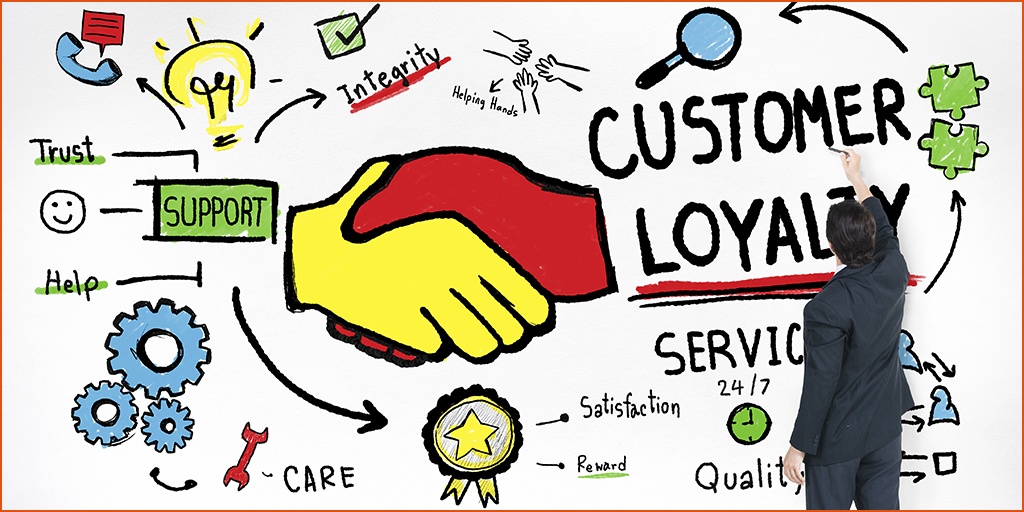
Customer Loyalty: The Secret Ingredient To Success
Customer loyalty is hard-won in this day and age.
With so many choices and so much of the world within quick reach, so many of the restrictions that used to get in the way of customers buying a product or service even thirty years ago have now vanished.
Life has become incredibly easier for consumers across the board.
Take for instance the example of a small town with no locksmith. Say you are living in the city and need a spare set of keys cut. Thirty years ago, you’d have to work out where the nearest town with a locksmith was, probably though combing through a massive tome of a telephone directory. You’d have to get in your car and travel to the next town – who knows how far away – to have another set made, probably at great time and expense to yourself. Then you would get to do it all over again the next time you needed another set. And heaven help you if you ever got locked out in the middle of the night.
Contrast that to the situation most of us find ourselves in today.
Say you live in a small town with no locksmith and you need a spare set of keys cut. You can now download an app to your phone that will allow you to scan a digital copy of your key and store it on your device, backed up to the cloud. You can order new copies of this key and have them mailed to you. Alternatively, a key can be made from this scan in under 30 seconds at automated kiosks across the country once your identity has been verified with a fingerprint. You can also choose to take a copy of this scan to a locksmith anywhere to get a new key made if your previous version is lost. You can share the scan with family and friends. If you get locked out, they could have a new key made in a heartbeat and come and bring it to you. This type of scenario is playing out in virtually every industry you care to name. Customer loyalty is a different game these days. It’s not about what’s reachable within a day’s drive anymore, how much it costs or fast it can be shipped to you. With these rational elements being leveled equally across most of the players in any industry now, the loyalty landscape has changed dramatically. Winning customer loyalty is now about a more complicated, subtle dance between company and customer.
The Secret Ingredient: Emotion.
In the words of industry leader Brand Keys, “The consumer decision process has become more emotional.” So much so that they estimate that most consumer decision processes now are 80% emotional and only 20% rational. Given this fact, how will your brand engage your customers on an emotional level? How can you increase customer loyalty from an emotional perspective? We present a two-step strategy to help you get started.
1. Increase Customer Loyalty by Identifying Shared Values
Your customers will be drawn to you because of your ‘why’. This is an incredibly powerful idea. So powerful that Simon Sinek’s TED Talk on the centrality of your ‘why’ has now had over 27 million views and counting. So what is your ‘why? ’Sinek envisages your organization’s ‘why’ as being at the center of a golden circle. Hubspot further explains that your ‘why’ encapsulates your business values – the deeper purpose of your business. The next circles are your ‘how’ and your ‘what’ – how the organization expresses those values in its operations and what it does to fulfill them. Sinek’s key argument is that marketers have it backwards when communicating with customers. They focus on the ‘what’ first and then start talking about the ‘how.’ They rarely get to the ‘why,’ if at all. The irony is that your ‘why’ is what connects with the customer on a deeper level. When your ‘why’ aligns with the customer’s ‘why’, that is where the magic happens.
2. Increase Customer Loyalty by Delivering On Your Promises
Aligning your ‘why’ with your customer’s ‘why’ is only the beginning of establishing an emotional connection with your customers. Having shared values will be what attracts the customer to you in the first place. It is what you do next that will (or will not) keep them there. How many times in the past have you heard that you should go over the top to try and exceed customer expectations? Probably many times. It might surprise you that in a survey of 75,000 consumers reported in the Harvard Business Review, the Corporate Executive Board, found that: delighting customers does not have an impact on customer loyalty. Keeping your promises does. All customers want is for you to deliver on your promises. That’s it – no bells, whistles, glitz or glam. Just do what you said you would. Be a person (or company) of your word. It’s almost too simple to be believed, isn’t it? And yet the evidence is there. The researchers go on to note that while many of us would assume that superlative customer service automatically increases customer loyalty, this is not necessarily the case. What is to be made of this? The key finding of the research was that customers want their problems solved quickly and easily. If you can do this, customers are less likely to leave. Devote a significant portion of your customer service strategy to reducing effort and frustration on the part of your customer.
Some suggestions for implementing this within your organization:
• Understand that customers are different. They have different emotional trigger points and different preferences for communication. Try and identify what these are early in your customer interactions.• Define your brand promises – explicit and implicit. Simplify them if you have to. Measure how well you are doing against them.• Map the customer journey. Put yourself and your team in their shoes. Eliminate or reduce pain points. Rinse. Repeat.• Anticipate customer service problems before they arise, not after. Apply predictive analytics and big data, if you have access to them. If not, here’s something that will be equally revolutionary: Engage your customers in conversation frequently. Think about what they might be needing next.• Make sure everyone on your team is on the same page. Resolving customer issues and making it easy for the customer should be the first priority, every time. Aim for consistency above all in your dealings with customers. The rules of customer loyalty game have changed. The new secret to winning this game: understanding that customer decisions are now much more about emotion than they are about cold hard rationality. Companies wanting to engage with their customers on a deeper level have to master two essential strategies: communicating shared values and delivering on promises. The truth is that it is ‘soft skills’ that will win over the customers of the future and turn them into lifelong raving fans. While facts will always be important, where customer loyalty is concerned it seems emotions will ultimately rule the day.







































































